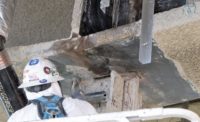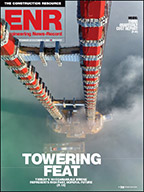Industry groups are joining forces to review recommendations for changes to structural and life-safety systems for tall buildings proposed by the National Institute of Standards and Technology as part of its $16-million World Trade Center Investigation. The recommendations released June 23 for public comment will form the basis of a debate on how future tall buildings will be designed and constructed and how building codes may evolve.
The National Council of Structural Engineers Associations, the American Institute of Architects and the Council on Tall Buildings and Urban Habitat are forming a joint a panel to review the draft report and provide an "official" opinion on the part of the profession. In addition, the Association of Major City/County Building Officials has announced it will review the draft and provide NIST with formal comments from the nations largest cities and counties.
Claude Cooper, AMCBO chairman and Richmond, Va., building official, said in a statement: AMCBO members are "gratified that this report reinforces the fact that tall buildings involved in the disaster were built safely and, for the most part, performed as they were designed.
"AMCBO is pleased NIST has offered thoughtful recommendations from their research for us to consider regarding the design, construction and operation of tall and iconic buildings," he said. "Our comments will include possible coordination of major city/county support for suggested code changes found in that report."
In additional to Richmond, some AMCBO members are New York, Chicago, Los Angeles, Detroit, Milwaukee, Denver, St. Louis and Philadelphia.
In the design arena, NIST is calling for changes to building standards, codes and practices, especially for structural and life safety system design and emergency evacuation of buildings. Specific recommendations concern stairs, elevators, fireproofing of structural steel, and structural integrity to reduce chances of progressive collapse in high-rise buildings during disaster situations.
Of particular concern at the World Trade Center was that 6% of the people who evacuated the two towersrepresenting about 1,000 individuals were physically challenged. "It appears that building commissioners need to consider ways to better accommodate the needs of these people," Cooper said.
Stephen S. Szoke, director of codes and standards for the Portland Cement Association, Skokie, Ill., says that many of NISTs proposals have already been discussed by professional organizations and other bodies but has been rejected, often because available "data" did not indicate a need for a change. He does not expect the NIST recommendations to further the push for changes in model codes.
"Most of the recommendations that relate to technical provisions of building codes have been discussed in the model code development arenas for the past several decades, including during the development and subsequent changes to the first edition of the International Code Councils International Building Code and National Fire Protection Association Building Construction and Safety Code, NFPA 5000," says Szoke "The Portland Cement Association and its allies in the cement-based product industries have initiated many of these discussions via code change proposals. Such proposals have attempted to strengthen code provisions by increasing the required fire resistance rating of the structural frame, eliminating sprinkler trade-offs and improving compartmentation by increasing the required fire resistance rating and/or requiring fire resistance rated barriers where codes presently do not require rated walls. Specific emphasis on required fire resistance rating has been related to exit stairway walls, by modifying the hose stream test of American Society for Testing and Materials E 119 Standard Test Methods for Fire Tests of Building Construction and, Materials to require a more rigorous test.
" Almost all of these proposals have been disapproved," he says. "The reason generally cited for their disapproval is that fire data does not indicate a need for the change. While PCA and our allied industry groups support many of NISTs recommendations, based on our experience over the past several decades, we do not anticipate any significant changes will be made in our model codes as a result of the NIST study."
 |
| Shyam Sunder |
NISTs recommendations are a result of studying only the behavior of occupants, emergency responders and the twin 110-story towers after the terrorist attacks on Sept. 11, 2001. But it is basing its recommendations on its findings related to procedures and practices commonly used for buildings under normal conditions, said S. Shyam Sunder, a NIST deputy director and the lead investigator in the three-year WTC study. Sunders remarks were made during a media briefing June 23, in New York City.
Sunder said NIST did not study any other commercial buildings or any other emergency scenarios in forming its recommendations. He did, however, say the "tragic consequences" of the Sept. 11 attacks were "directly attributable to the fact that terrorists flew large, jet-fuel-laden commercial airliners into the WTC towers." He also said that "buildings for use by the general population are not designed to withstand aircraft attacks" and that "building codes do not require building designs to consider aircraft impact."
In earlier briefings, Sunder made it clear that the twin towers performed well on 9/11 and that the fact that they did not collapse on impact of the jetliners is a tribute to their structural redundancy, which saved thousands of lives.
Still, he said "public officials and building owners will need to determine appropriate performance requirements for buildings that are at higher risk due to their iconic status, critical function or design."
The public comment period will end at the end of the business on Aug. 4, Eastern Daylight Time.. NIST is holding a conference to discuss putting its recommendations into practice on Sept. 13-15, in Gaithersburg, Md. The final WTC report will be issued in September.
The NIST report on Seven WTC, which collapsed on 9/11 after burning unattended for about five hours, will be released in draft form in October and final form in December.
Sunder said NIST believes its recommendations are realistic and achievable within "a reasonable period" of time and that implementation of the recommendations would make buildings, occupants and emergency responders safer in future emergencies.
The recommendations do not prescribe specific threshold levels. Sunder says this is not the responsibility of NIST.
The recommendations that relate to "increased" structural integrity are that progressive collapse should be prevented in buildings through development and nationwide adoption of consensus standards and code provisions, with tools and guidelines needed for their use in practice. NIST recommends developing...


